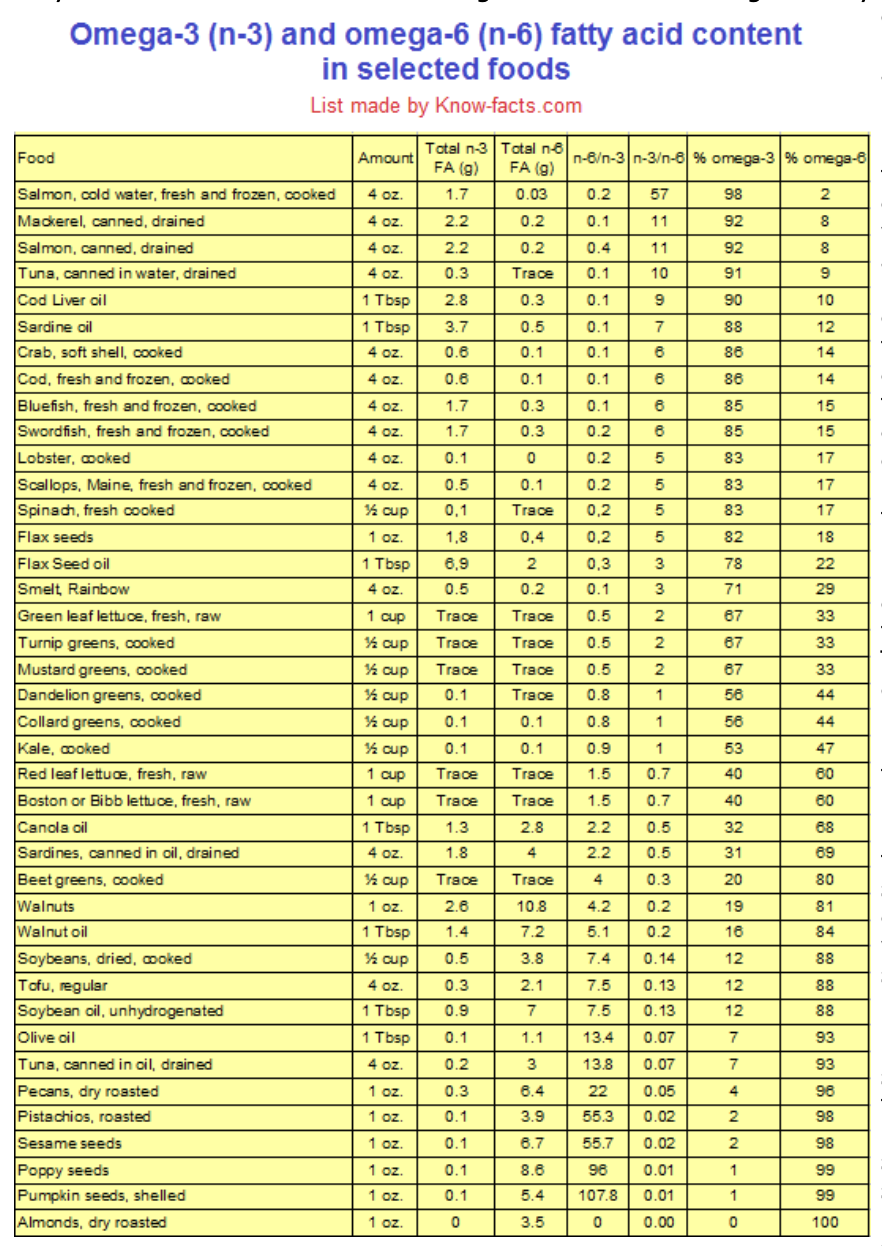
NUTRITION FOR PAIN RELIEF: OMEGA-3 ESSENTIAL FATTY ACIDS
Mar 27, 2023We tend to overemphasize healing the site of injury when we're injured - whether that’s a broken finger, a sprained ankle or a herniated disc.
We wrap the thing, we put ointment on the thing, we may ice (or heat) the thing, and then we tend to (over)focus on “the best exercises” to heal the thing.
But...one of the most obvious ways for you to get better faster is by adopting more proactive nutrition and hydration habits.
WHAT ARE ESSENTIAL FATTY ACIDS AND WHY DO THEY MATTER?
Essential fatty acids, or EFAs, are a type of unsaturated fatty acid that the body cannot produce on its own, so it must be obtained through diet.
These fatty acids are critical for maintaining good health and play a vital role in a number of bodily processes, including brain function, skin health, and inflammation control.
Foods high in Omega-3 fatty acids include fish, vegetable oils, nuts (especially walnuts), flax seeds, flaxseed oil, and leafy vegetables.
Essential fatty acids, such as omega-3 and omega-6, are important for the production of prostaglandins, which are hormone-like substances that play a critical role in many physiological processes in the body. In short, you need to consume essential fatty acids in order to produce the right amount of prostaglandins.
You can read more about Pain and Prostaglandins in this related article.
Prostaglandins are involved in regulating inflammation, blood clotting, blood pressure, and immune function, among other things.
So when you don’t consume the right proportion of essential fatty acids in your diet, your body won’t be able to produce enough prostaglandins or you may end up overproducing prostaglandins.
Any imbalance can lead to chronic pain, inflammation, cardiovascular disease, arthritis, and skin disorders. This is why it’s important to integrate sound nutritional advice as part of your back pain plan.
WHAT'S SO SPECIAL ABOUT OMEGA-3’S?
So what makes omega-3 fats so special? They're an integral part of cell membranes throughout the body and they affect the function of the cell receptors in these membranes.
In a previous article, I discussed the importance of understanding the role of nutrition, specifically, the role that prostaglandins play in our body for managing pain and inflammation. Now you can see the importance of essential fatty acids for your body's synthesization of prostaglandins.
Essential fatty acids create prostaglandins and prostaglandins regulate blood clotting, contraction and relaxation of artery walls, and... inflammation.
They also bind to receptors in cells that regulate genetic function. Likely due to these effects, omega-3 fats have been shown to help prevent heart disease and stroke, control lupus, eczema, and rheumatoid arthritis, and play protective roles in cancer and other conditions.
THE TWO MAIN TYPES OF EFA’S
There are two main types of essential fatty acids: omega-3 and omega-6.
Omega-3 fatty acids are primarily found in fish, nuts, and seeds, while omega-6 fatty acids are found in vegetable oils and meat. Both types of EFAs are necessary for optimal health, but the ratio of omega-3 to omega-6 intake is crucial.
Omega-3 fatty acids, specifically EPA (eicosapentaenoic acid) and DHA (docosahexaenoic acid), are important for brain function and the health of the nervous system.
They have been linked to a reduced risk of depression, Alzheimer's disease, and other cognitive disorders. Omega-3s also play an important role in reducing inflammation throughout the body,
There are three main kinds of omega-3s:
- Eicosapentaenoic acid (EPA) and docosahexaenoic acid (DHA) come mainly from fish, so they are sometimes called marine omega-3s.
- Alpha-linolenic acid (ALA) is the most common omega-3 fatty acid and it can be obtained from vegetable oils and nuts (especially walnuts), flax seeds, leafy vegetables, and in certain grass-fed animal fat.
- My understanding is that your body uses ALA for energy, and that it’s conversion into EPA and DHA is limited
WHAT ARE THE RISKS OF CONSUMING TOO MUCH OMEGA-6 FATTY ACIDS?
It is important to reduce your intake of processed and fast foods, which are high in omega-6 fatty acids.
Excessive junk food consumption will throw your omega-6 to omega-3 ratio out of balance. The risk here is that over indulging in omega-6 foods is directly linked to inflammation, which is responsible for a number of serious chronic diseases such as heart disease, cancer, and autoimmune disorders. It is important to balance omega-6 intake with omega-3 intake.
The recommended ratio of omega 6's to 3's is about 3:1 or 4:1 however most Americans' ratios are closer to 15:1 because of our over-dependence on frozen, packaged, convenience and snack foods.
The obvious suggestion here is to avoid packaged, take-out and convenience foods whenever possible. Instead, opt for whole foods that are rich in healthy fats, such as olive oil, avocados, nuts, and seeds.
WHICH FOODS SHOULD YOU EAT TO GET MORE OMEGA-3’S?
So, how can we ensure we are getting enough essential fatty acids in our diet?
One way is to consume whole foods rich in omega-3s, such as fatty fish (salmon, anchovies, sardines, tuna, mackerel).
In addition to seeds, flaxseed, chia seeds, walnuts, and soybeans, there are also algae-based supplements which can supply omega-3s for vegans.
In summary, essential fatty acids are crucial for maintaining good health, and it is important to ensure a balanced intake of omega-3 and omega-6 fatty acids.
When you start to intentionally incorporate more omega-3 food sources into your diet, while reducing the amount of processed and fast foods you eat, you can reduce your inflammatory load while actively supporting your body’s natural healing abilities.
If your goal is to heal faster, to experience less pain for a shorter period of time, get ahead of inflammation by making smart choices at every meal!
The following table lists omega-3 and omega-6 content of common foods:

This second table lists common fish and seafood products and their omega-3 fatty acid content:
|
Type of Seafood |
Serving Size |
Omega-3 Fatty Acids (mg/serving) |
|
Anchovy |
2.0 oz |
1,200 |
|
Catfish (farmed) |
5.0 oz |
253 |
|
Clams |
3.0 oz |
241 |
|
Cod (Atlantic) |
6.3 oz |
284 |
|
Crab |
3.0 oz |
351 |
|
Fish sticks (frozen) |
3.2 oz |
193 |
|
Halibut |
5.6 oz |
740 |
|
Lobster |
3.0 oz |
71 |
|
Mahi mahi |
5.6 oz |
221 |
|
Mussels |
3.0 oz |
665 |
|
Oysters |
3.0 oz |
585 |
|
Pollock (Alaskan) |
2.1 oz |
281 |
|
Salmon (wild) |
6.0 oz |
1,774 |
|
Salmon (farmed) |
6.0 oz |
4,504 |
|
Sardines |
2.0 oz |
556 |
|
Scallops |
3.0 oz |
310 |
|
Shrimp |
3.0 oz |
267 |
|
Swordfish* |
3.7 oz |
868 |
|
Trout |
2.2 oz |
581 |
|
Tuna (albacore)** |
3.0 oz |
733 |
|
Tuna (light, skipjack) |
3.0 oz |
228 |
SOURCE: Mozaffarian D, Rimm EB. JAMA. 2006;296:1885-1899.
Terms of Use
The contents of this website are for educational purposes and are not intended to offer personal medical advice. You should seek the advice of your physician or other qualified health provider with any questions you may have regarding a medical condition. Never disregard professional medical advice or delay in seeking it because of something you have read on this website.

